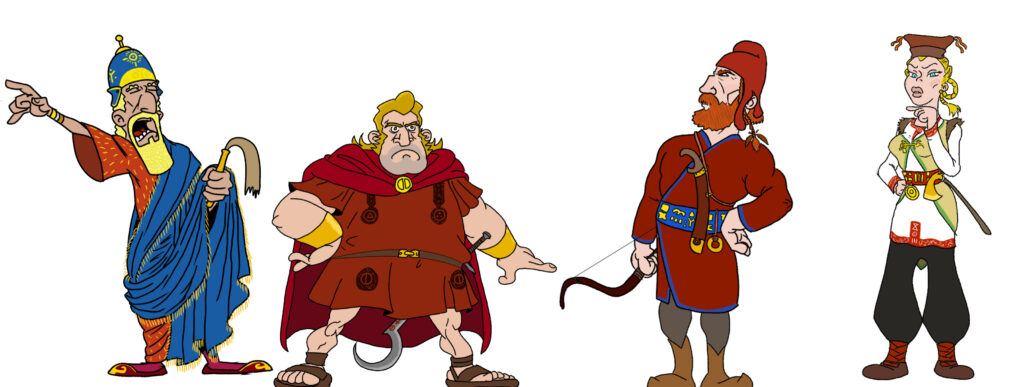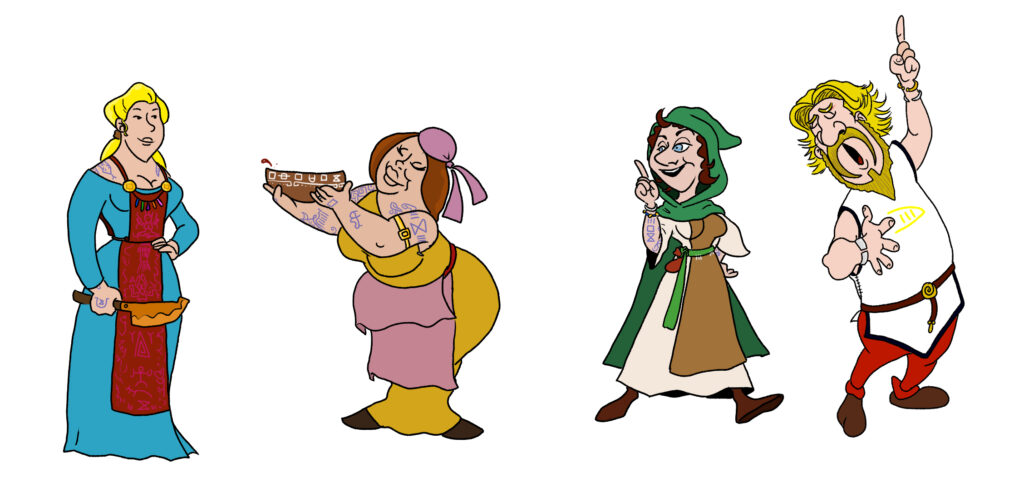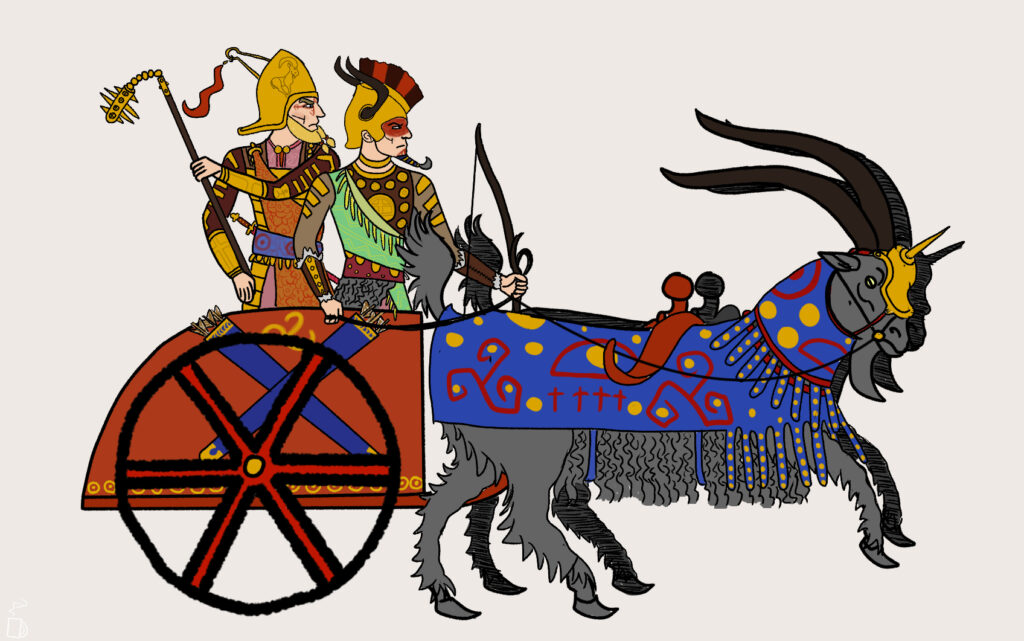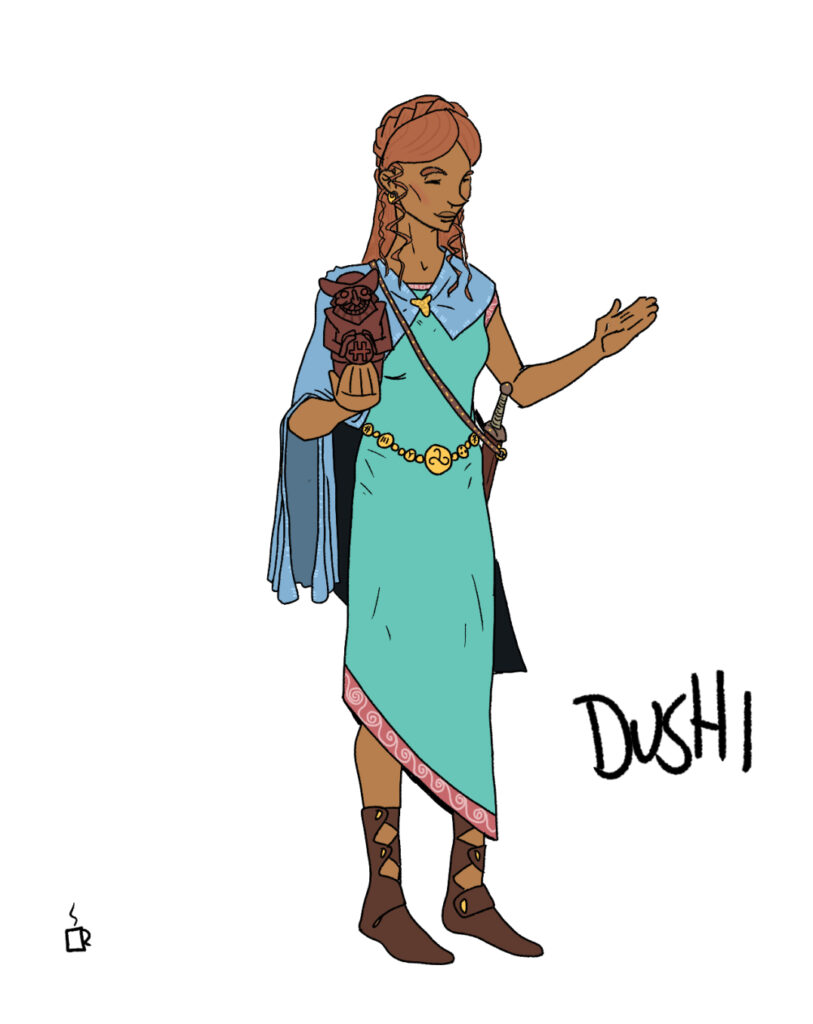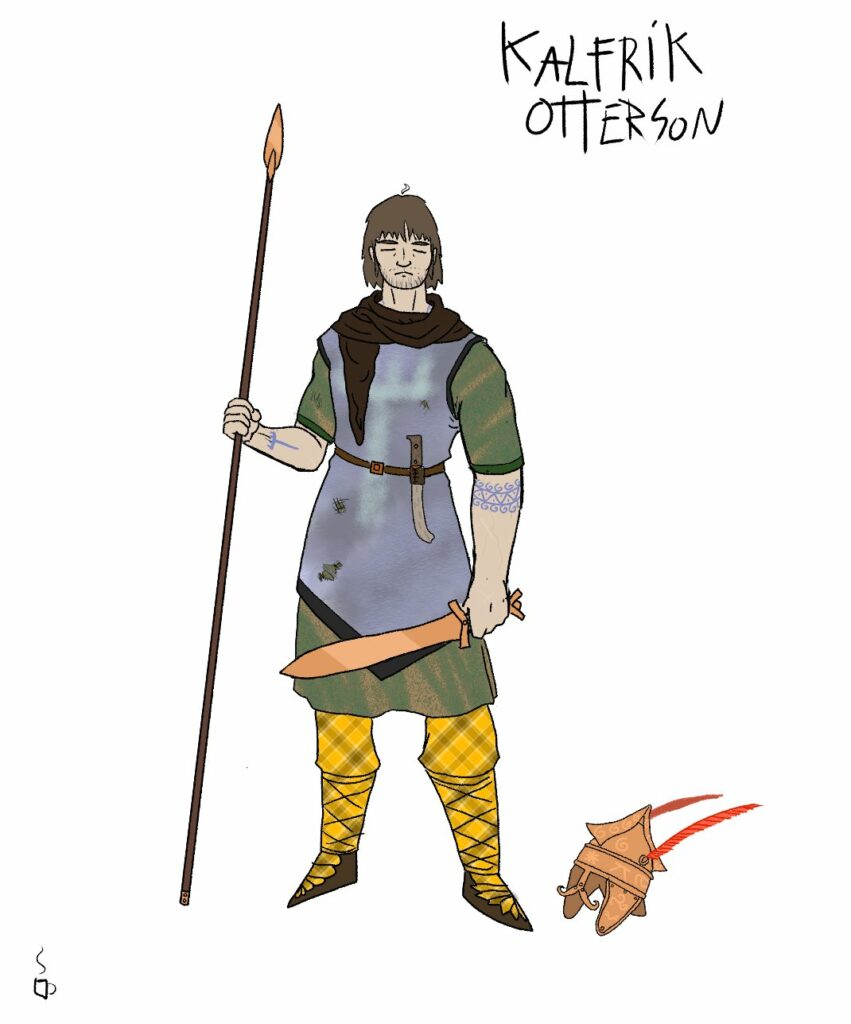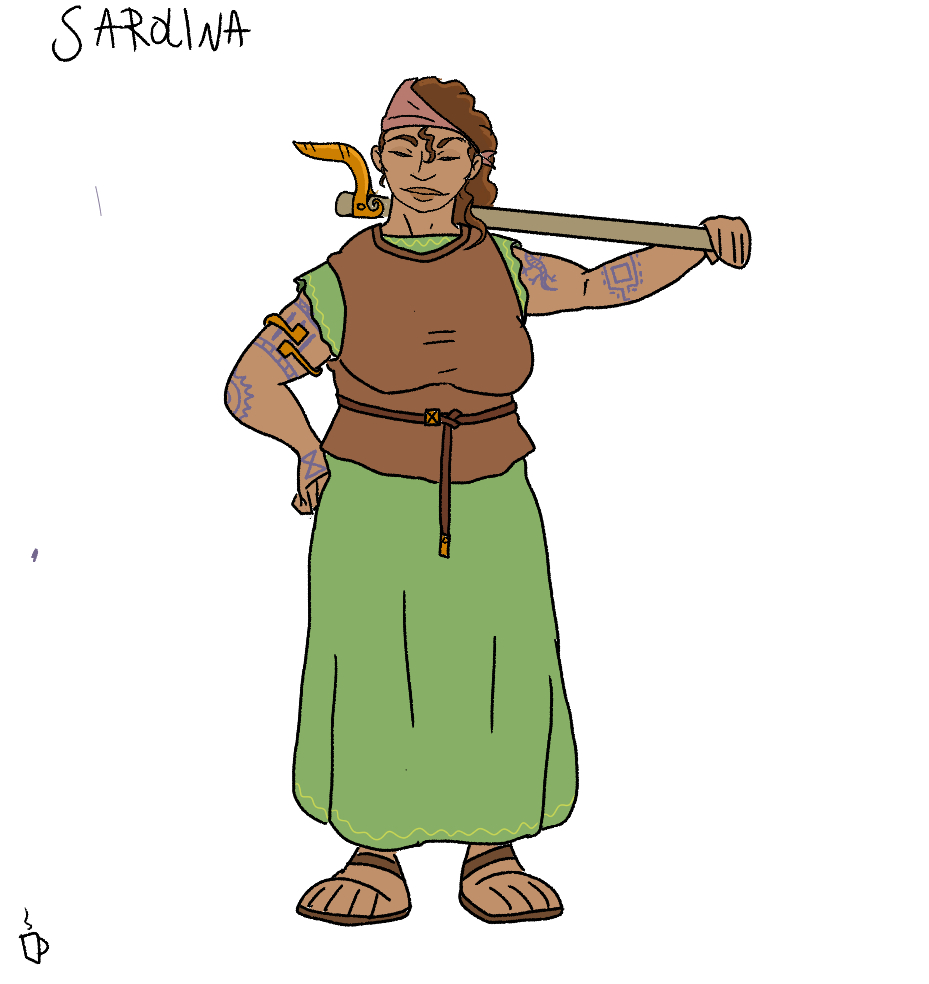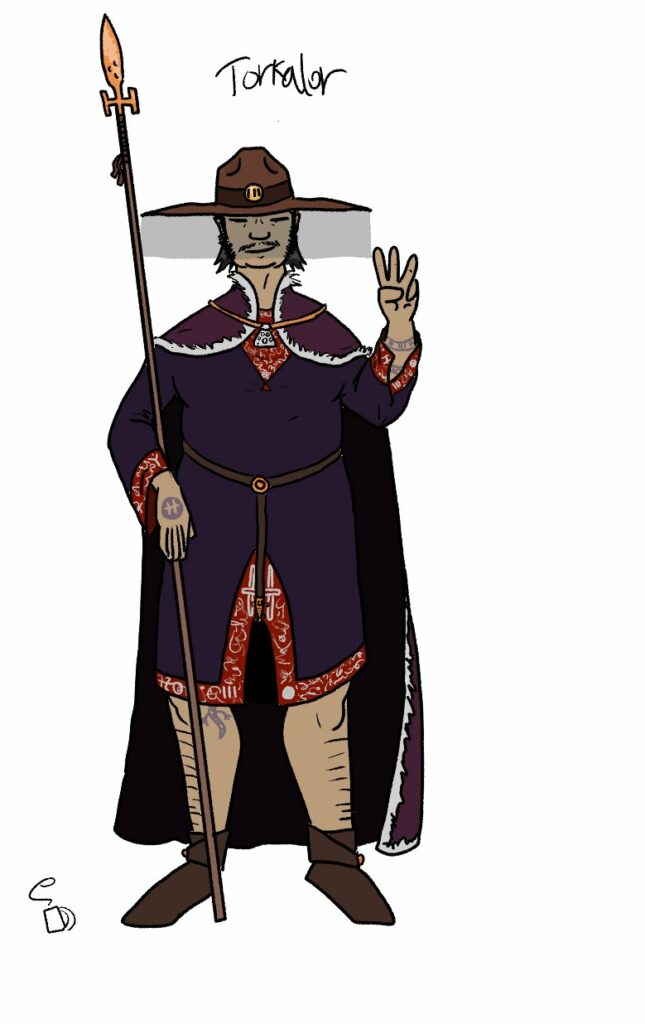Welcome to a new issue of the Journal of Runic Studies, the premier Malkioni publication for studies into the nature of Glorantha. If you haven’t subscribed yet, please consult with the spirit bound to the appropriate electronic page.
God Learner Sorcery
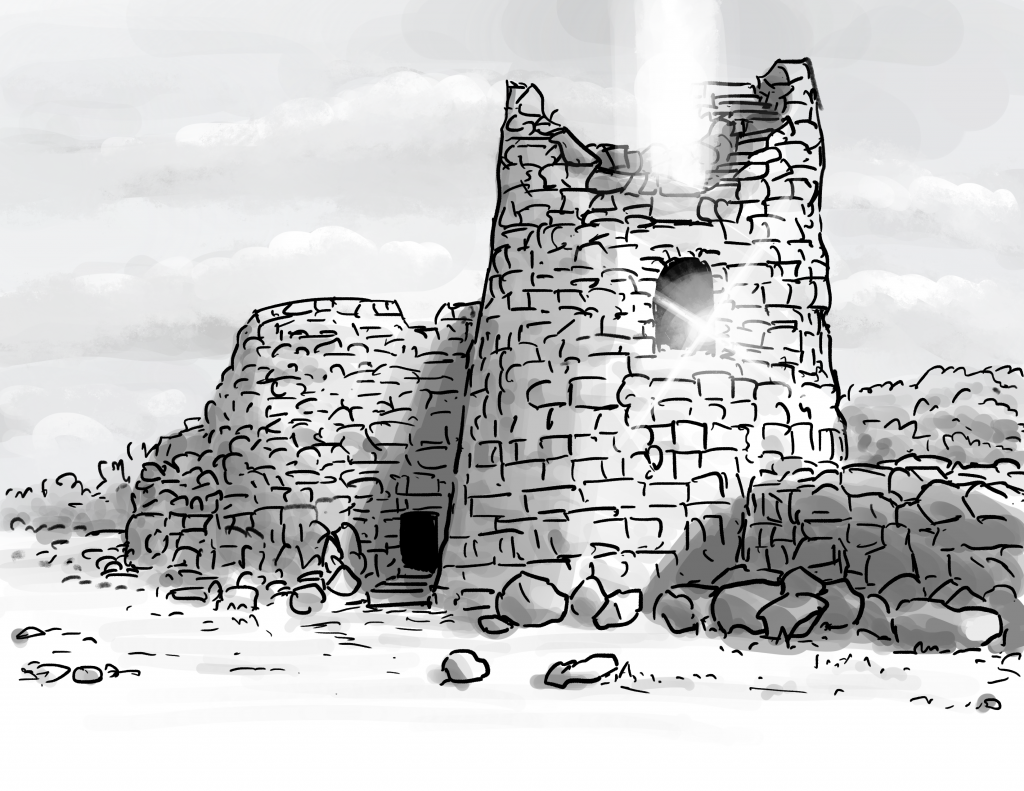
Here is what us God Learners were up to this week.
Episode 18: The Travels of Biturian Varosh (Part 5)

Drew Baker is back to accompany Ludovic on the last leg of Biturian Varosh’s travels! We share crazy conspiracy theories, nerd-out on logistics and prices, complain about heroquesting, and more as we reach the end of RuneQuest’s Cults of Prax.
Chaosium News

Here are this week’s Chaosium news!
Get Khan of Khans While You Can!
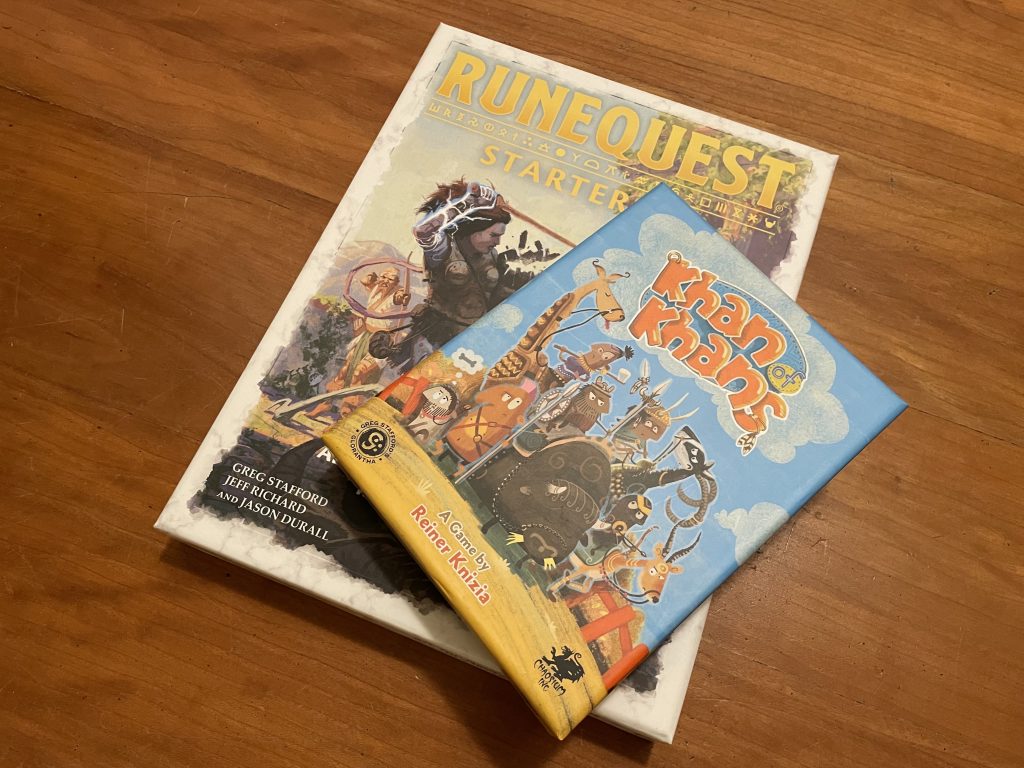
The absolute best way to introduce anybody to Glorantha, the Ennie-winning, simple and fast-paced fun board game “Khan of Khans“, is sadly being withdrawn from sales soon, so grab it while you can!
The Chaosium blog explains:
Due to our licensing collaboration with Dr Reiner Knizia concluding at the end of the year, we will be withdrawing both titles from sale on December 31st, 2022.
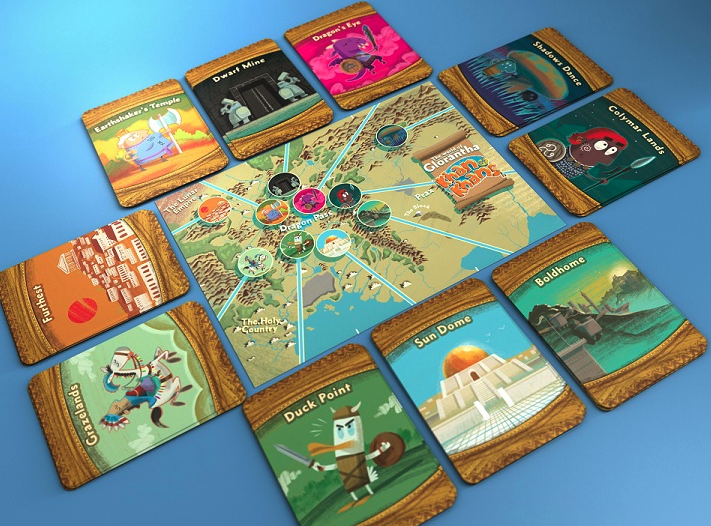
Of note, the Call of Cthulhu themed Miskatonic University: The Restricted Collection board game is similarly going out of print at the same time. You can order Khan of Khans and Miskatonic University: The Restricted Collection, from Chaosium.
I already have Khan of Khans, but I just bought a second one while ordering some Call of Cthulhu stuff… it will come in handy for a gift at some point, I’m sure.
A New Hero: Episode 10
This great actual play of RuneQuest, GMed by James Coquillat, continues to delve deeper into the Upland Marsh! There is probably some vampiric shenanigans going on, based on the description and what I have seen catching up to Episode 8. Note that, as of Episode 7, Bridgett and Dave are joined by Harli, who plays a young Humakti assistant-priestess who gets a sudden promotion…
Jonstown Compendium

The Jonstown Compendium is Chaosium’s community content program for all Gloranthan games, hosted on DriveThruRPG. Disclaimer: all the relevant links are affiliate links that hopefully will let us cover some of the hosting and maintenance costs for the website and podcast! Thanks for using them!
The Indagos Bull
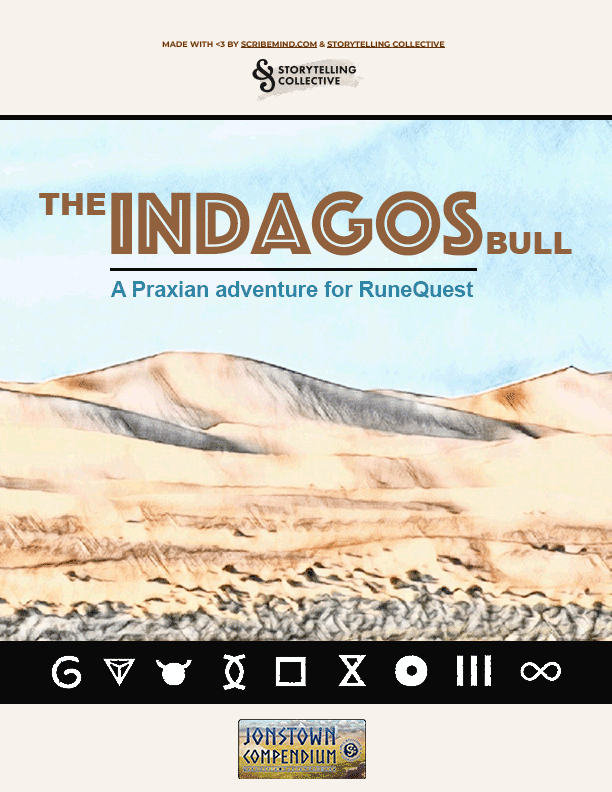
This short Praxian investigation scenario by Rob Marcus already has a 5 star review from Nick Brooke:
It is two days before the Eiritha High Holy Day, and Farmer Jyles’ prize bull has gone missing! The Eiritha priestess is worried that the community blessing ceremony will be affected. However, there is a rumour that Jyles’ neighbour has a secret, and Jyles’ lazy son has been looking pleased with himself.
Contains details of Indagos town, Pavic meat trade, farming in Prax, and what happens when you tangle with a Hazia Elf.
Rubble Runners Volume 2

Jon Hunter follows up the first volume with another set of NPCs from Pavis. In addition to the NPCs themselves, there are short write-ups for contacts, companions, and scenario hooks.
Hydra: Adventurers from the Lunar Provinces
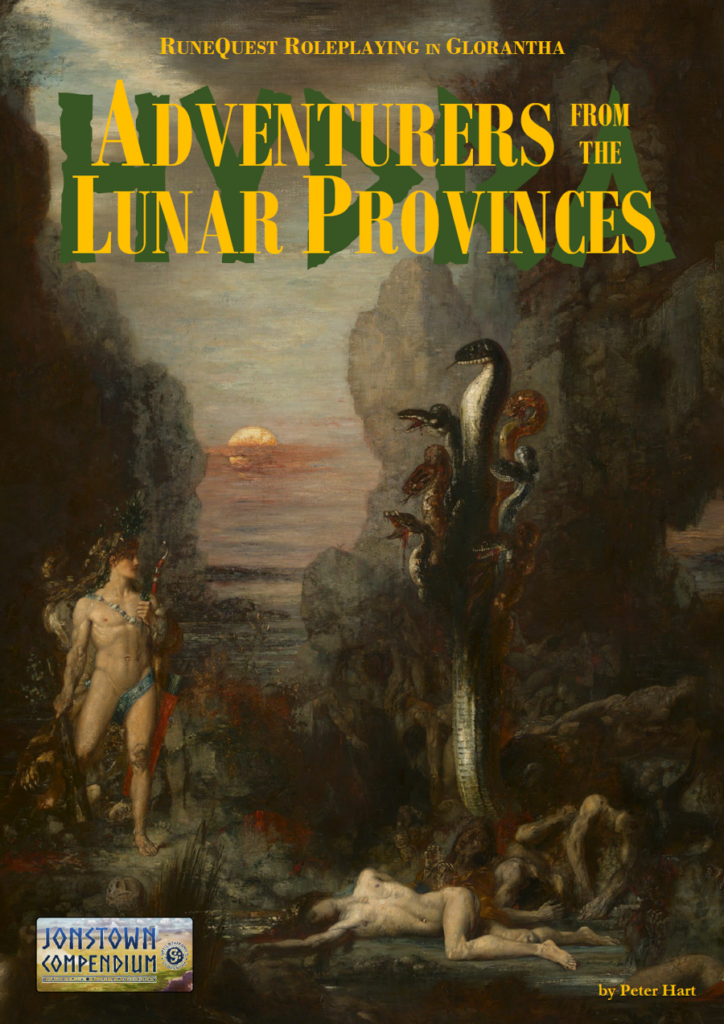
Hydra is a sourcebook for creating adventurers from the Lunar Provinces (Aggar, Holay, Imther, Tarsh, and Vanch). Twenty adventurers are also provided, so you can use that book for pre-gens or NPCs, too.
Jeff’s Notes

Jeff Richard, the current mastermind on everything Gloranthan at Chaosium, is often posting notes and thoughts on the RuneQuest Facebook group. Here’s our curated list from the past week. A partial archive of these sources is compiled on the Well of Daliath.
Geographical Context in Central Genertela
Jeff does this occasionally: he provides a bit a geographical context about this or that place, maybe with a reference photo or two, so that you can better picture that place the same way he does (you might still go on to play it differently, but there’s value in knowing what the designers have in mind!)
Since a good chunk of Chaosium was away on multiple conventions such as Dragonmeet and PAX, I suppose Jeff had a good quiet week and that’s why there are quite a few notes on that topic!
Prax and the Wastes
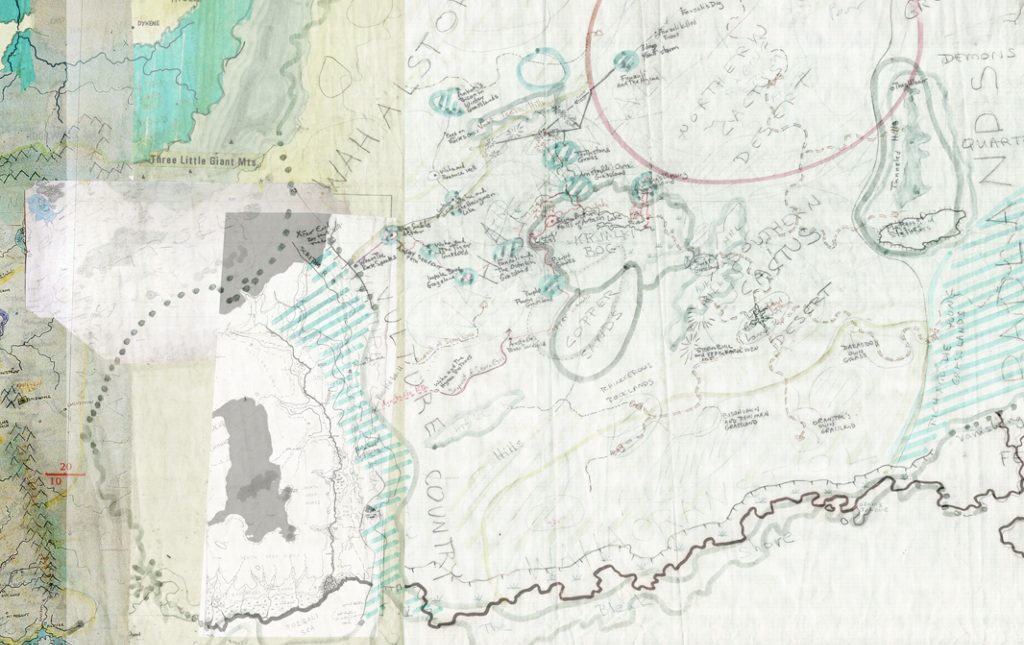
The note on Prax and the Wastes shouldn’t have anything surprising in it. As I think back on my first discovery of Prax, the main misconceptions I had were:
- Praxian nomads live in Prax: that’s sadly not true, and I wish they would have a different name (I notice Jeff uses “Animal Nomads” once instead of “Praxians”). It turns out they spend a lot of time riding around Genert’s Wastes, too… which makes sense because nomadic tribes of that size (almost 400,000 people) need a lot of space, and this went into my original pet peeve of “Glorantha is too small for its own good“.
- Chaparral deserts are just an endless flat plane of dry land with some scrubs: that was obviously my own ignorance on the topic (not many deserts in Western Canada or France…) but I realize now that Prax is probably a lot more geographically interesting than I originally thought.
If you want to better picture how the nomad tribes move around the Wastes, don’t forget this map by David Scott that shows the various grazing lands:
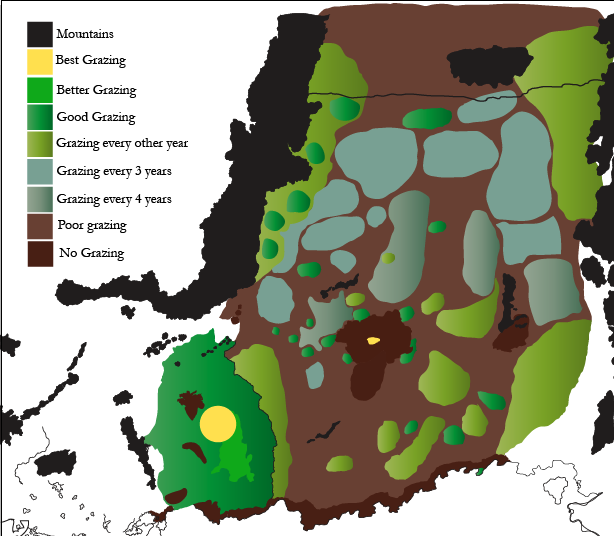
Peloria
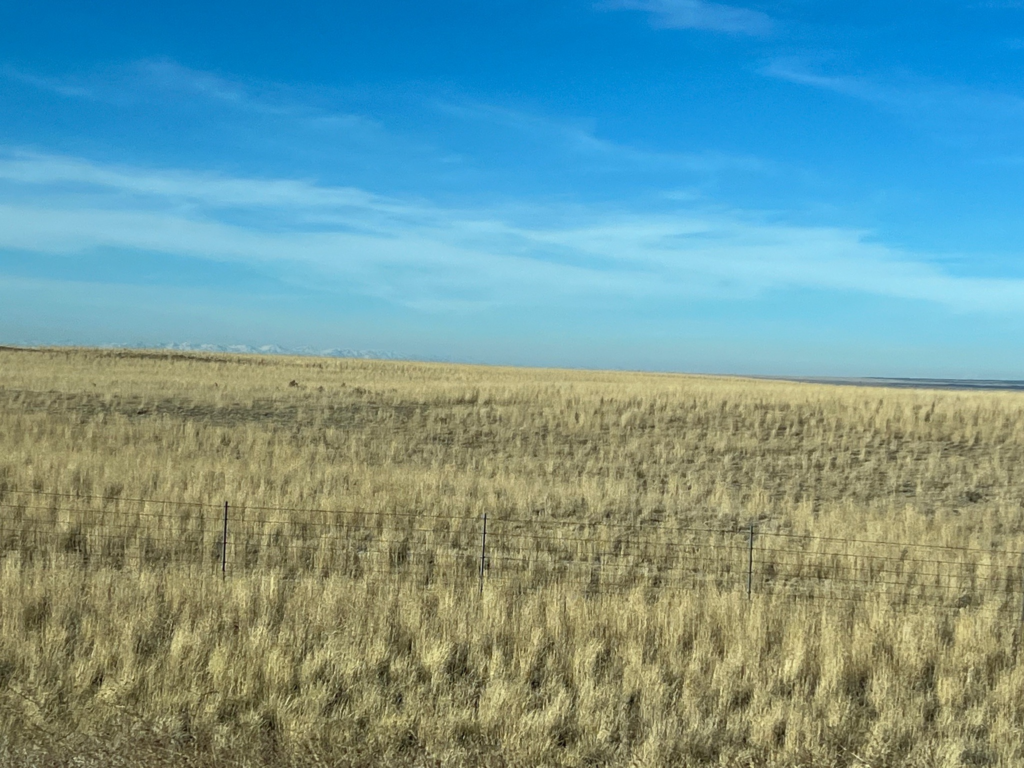
This note on Peloria is more about the climate than geography (plus a bit on agriculture) but it has one interesting thing: some reasoning about why Lodril is both a god of Pelorian farmers and a god of volcanic fire… what’s the link between the two?
And of course there is the occasional basalt flood from Lodril. This was something that troubled me – we know Peloria is the center of Lodril’s cult and yet there is an apparent shocking lack of volcanic activity in Peloria. But of course that is not true – we have accounts of the Ervuthan Lava Beds in Vonlath. and there are no doubt others.
The Ervuthan Lava Beds are a place where the god Antirius buried some bad Dara Happan emperor and his followers using earthquakes and fire, or something. That’s a deep Gloranthan cut, here (I want to thank the search feature in my PDF reader). From a cursory search, Antirius seems to be an early Dara Happan version of Yelmalio, from before Time. This whole Ervuthan Lava Bed incident also happened before Time as far as I can see.
Vonlath is an area of fertile lands that covers parts of Kostaddi and Darjin, smack in the middle of the Lunar Empire. I imagine that it runs along the Oslir river between Glamour and Jillaro:
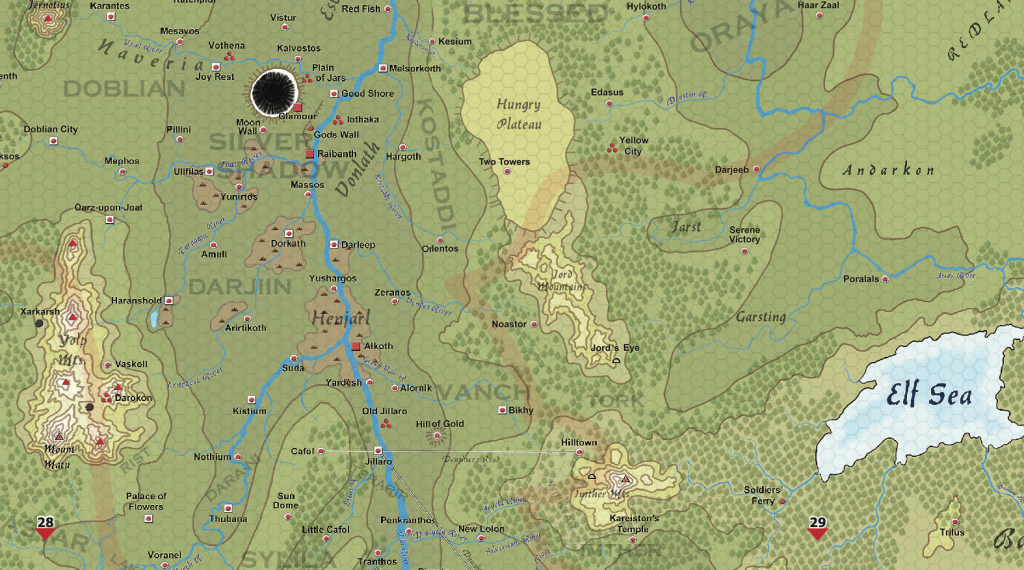
While driving across the Snake River Plain, it became obvious – of course there are areas of basalt rock in lowland Peloria, surrounded by grain and rice fields. And these places are of course sacred to Lodril.
The Snake River Plain is a stretch of land in the USA that crosses Idaho (mainly) and features several volcanic buttes.
Okay so we have volcanic rock in various places along the Oslir valley, and in the real world this kind of rock can apparently be crushed into dust as a way to improve soil health and increase agriculture yields. In that way, I suppose that Pelorian farmers only need to worship whoever made that basalt rock. It’s hinted in The Glorious Reascent of Yelm that Antirius got help from the Earth goddesses to accomplish his napalm carpet bombing, and Antirius has a lot more to him than just that, so it makes sense that Pelorian farmers turned to a deity that just symbolizes the creation of basalt — “fire dude burns the earth but in a nice way“. In some way, Lodril could be considered the personification of Antirirus’ weapon, or of Antirius’ “alliance” with Earth at that time. There’s a lot of polytheist gods that started their career as someone else’s magic item or action, after all.
But that doesn’t quite explain to me why Lodril became the primary farmer god, as opposed to a side god that you worship for added soil fertility. I suppose that the Pelorian farmers have such a dull life that all the big penises and hot sex action in Lodril’s iconography was too attractive, and they stopped bothering much with the other very very serious solar gods…
The Quivin Mountains

This note on the Quivin Mountains (the small mountain range around Boldhome) features a new version of a map we had previously seen… nice!
One thing I didn’t know:
Part of the mountain range is formed by the resting giant Thorgeir.
That part is the Culbrea Mountains, with the “Shoulder” and the “Knee”. Apparently there’s a whole story about this: the giant Thorgeir gave a cow to Quivin, a half-brother of Orlanth, but tried to take it back later. Quivin slew Thorgeir, and that’s where he rests. And that’s also why there’s another peak called Thorgeir’s Cow here, by the way.
The Quivin Mountains also highlight once again my “Glorantha is too small” pet peeve. This mountain range is, what, a 20 kilometres wide square of land? That’s very small… although technically you can find a few small mountain ranges like that on Earth if you look closely. And after my initial shock I also realized that Glorantha isn’t built from, you know, tectonic activity and erosion: this is where the god Quivin sat down and where the giant Thorgeir fell down. So of course it’s just a handful of peaks in the middle of rolling hills… but it took me a while before this realization. That’s something to keep in mind when you bring new people to Glorantha.
The other “solution” is to simply connect the Quivin Mountains to the Storm Mountains to the south and, lo and behold, you have a still small but much more “realistic” mountain range, similar to, say, the Jura in France.
The Guardian Hills

The Guardian Hills make up the area around Swenstown, where eastern Sartar meets with Prax. You can read the note for some climate and geographic data — it’s basically hills with seasonal rivers and mediocre vegetation that looks super awesome to the average Praxian.
The East Wilds
At first I was confused and I thought this was about the Elder Wilds, but no, this is about the East Wilds, which is a different place. Of course. And of course, it’s Ralios, in the western part of Genertela. To be fair, it’s in the eastern part of Ralios. Eastern part of the western part. Okay, sure.

To orient yourselves: the East Wilds are roughly ranging from Naskorion through Delela to Halikiv (on the left half of that map above), although Halikiv is set apart because that’s troll land. Past that, to the east, is where the Skyreach Mountains (to the north) meet the Mislari Mountains (to the south). So the right side of that map is Esrolia (in the bottom right corner), the Grazelands (right edge), and Lunar Tarsh (top right corner).
Orlanth and his Lightbringer deities dominate the East Wilds, along with Yelmalio, and numerous spirit cults.
While the Orlanthi “dominate” the area, there are also many Hsunchen tribes (which we talked about with Brian Duguid on the podcast). There’s also a Sun Dome temple there from the old days of the EWF… keep that in mind, we’ll get back to it later.
The East Wilds are hostile towards the trolls of Halikiv, and their great hero, Retter the Stalker, unified the tribes of Delela through his raids deep into Halikiv. Despite this, nocturnal troll caravans under the protection of the Argan Argar Chain travel between Halikiv and Safelster. Chaos monsters sometimes invade from Karia.
Beyond the East Wilds are the Western Rockwoods, a high mountain range, with few passes. Kartolin Pass is the easiest and best known, but it is blocked by Castle Kartolin – and beyond is the haunted land of Dorastor.
Safelster is out of the map to the west (that’s the heart of Ralios). Karia is up north near the Kartolin Pass, which you don’t want to go through given what’s on the other side.
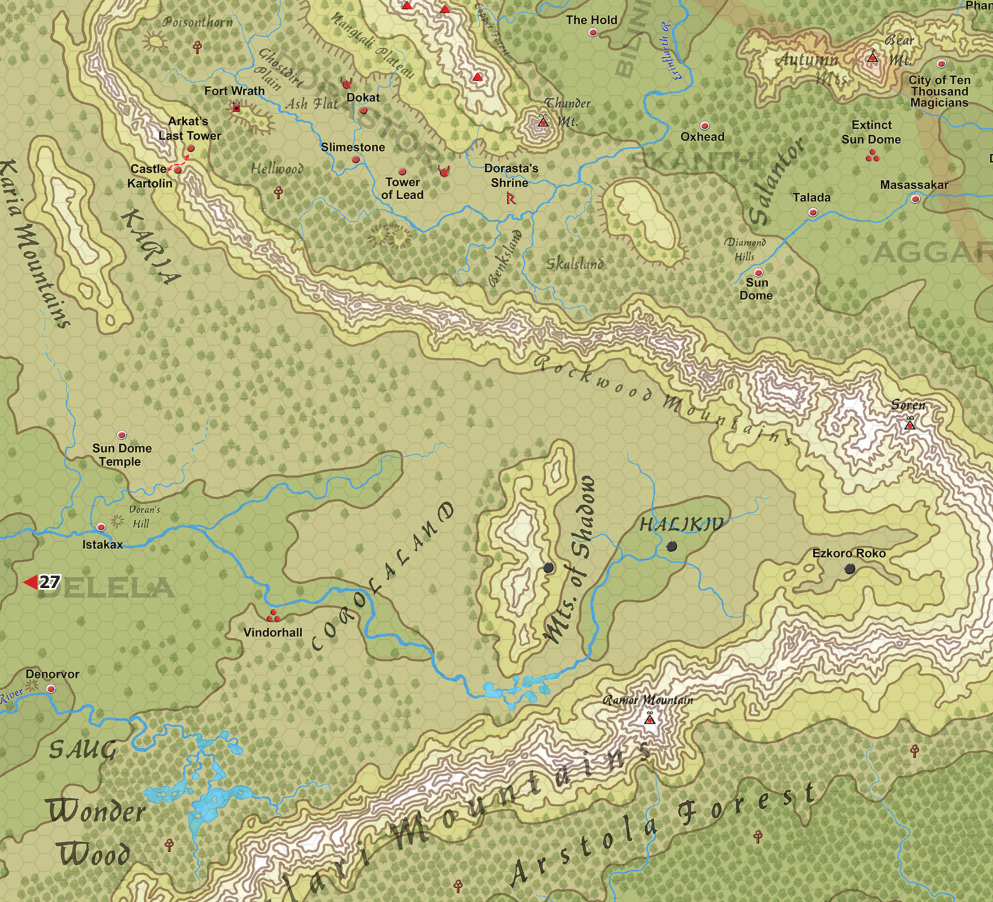
The Guide mentions that people have started settling Karia again, and report that “it’s actually not that bad“. Nobody really believes them though… so what’s going on? I guess you’ll have to go there… On the other hand, I’m sure that finding another good pass elsewhere through the mountains (especially one that leads to Aggar or Tarsh) would be super interesting to the Lunars. Maybe your adventurers want to do that instead?
The Sixes of the Holy Country
The Holy Country used to be organized like a magical Disneyland by Belintar until his disappearance.
In the Holy Country, the magical energies of the Sixes work together to complement each other. All Six are recognized by all and yet, each maintain their own identity. The Sixes and their ruling deity are:
– Water (ruling the Rightarm Islands and the Bay) – Magasta (Choralintho, Dormal)
– Fire (ruling Caladraland) – Lodril (Yelmalio)
– Earth (ruling Esrolia) – Ernalda (Maran Gor, Asrelia, Grain Goddesses, Ty Kora Tek)
– Darkness (ruling the Shadow Plateau) – Argan Argar (Kyger Litor, Zorak Zoran)
– Air (ruling Heortland) – Orlanth (Storm Bull, Humakt)
– God Forgot (ruling the Leftarm Islands) – none

These elemental powers operate in a lesser manner in the other Sixths, and I imagine Lullian circles with six fields are depicted spinning around each other, clockwise and counter clockwise, to show this.
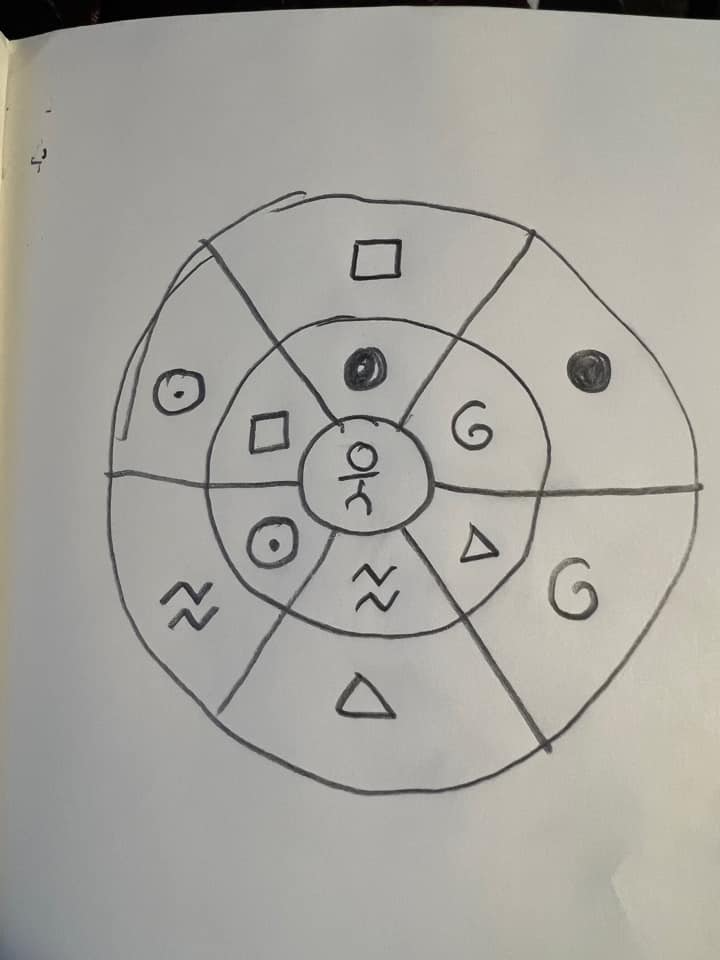
Llullian circles are coming from the alchemical work of Ramon Llull, a 13th century Spanish philosopher. He used these types of circles a lot in his books:
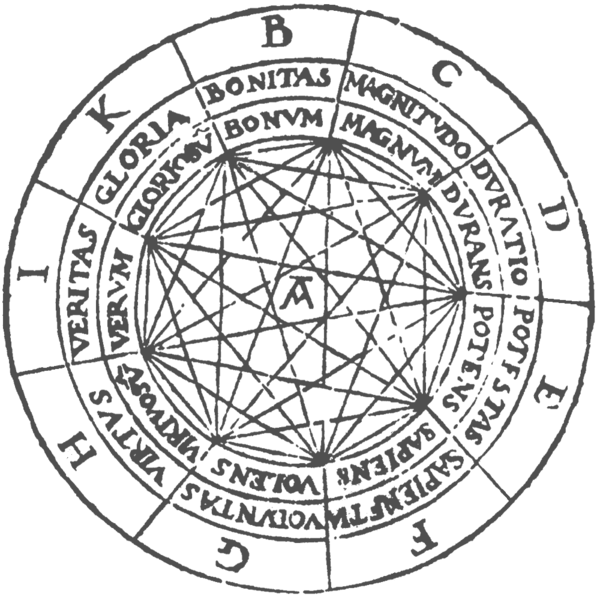
So going back to the six Runes and deities of the Holy Country, I think the inner circle shows the main ruling power of the sixth (Esrolia/Earth and Caladraland/Fire to the west, the Shadow Plateau/Darkness to the north, Hendrikiland/Air and God Forgot/Law/nothing to the east, and the Rightarm Islands/Water to the south).
I suppose you could rotate the outer circle to make up whatever combination you want — coming up with stories as needed. And speaking of stories…
A God Forgot Story
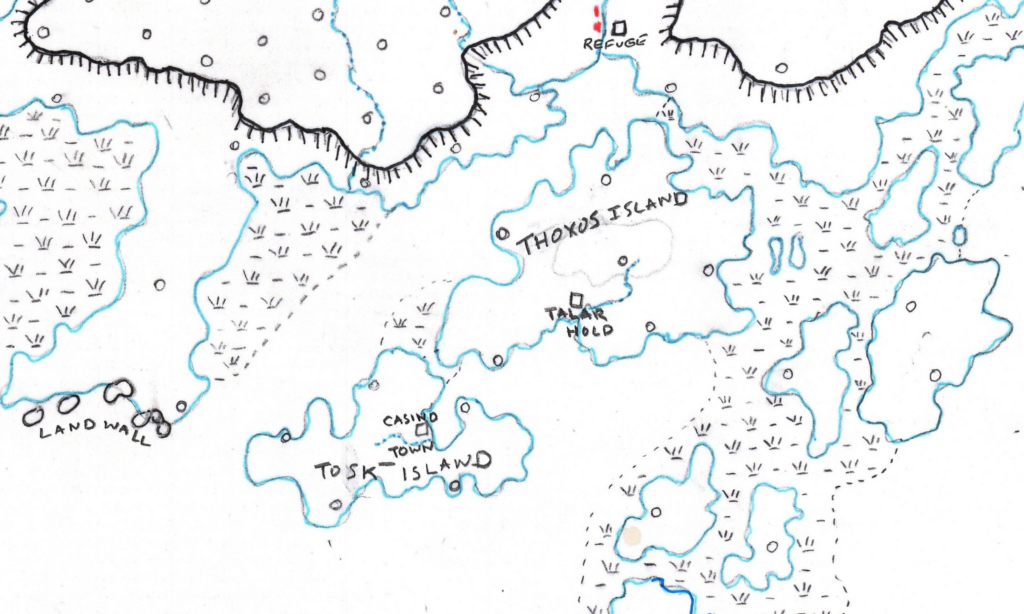
Here is a story from God Forgot. Apparently there was indeed a guy named “God-forgets”. Huh, who knew? Also, I love the concept of “accidental worship of the Trickster God“.
Anyway, the story is complemented by some details about how bonkers this area is:
God Forgot has many strange locations. Of course there are the Clanking Ruins (sometimes known as the Machine Ruins or the Factory Ruins), but Casino Town is perhaps the most emblematic of modern God Forgot philosophy. There are many types of gambling places there, as well as a cult which promotes suicide and The Bank, which worships Our Lady of Credit.
If you think about Casino Town, it is a place of about 5000 (so about the same population as New Pavis), centered around gambling places and The Bank. The gambling places are claimed to be temples to Luck and Fate, while The Bank is claimed as a temple to Our Lady of Credit. I doubt any of these “cults” offer any magic – their rewards are entirely tangible.
My first thought is that, on the contrary, the risks and rewards might be completely weird… gamble your ability to scratch your nose when it itches, but maybe you’ll win the ability to cross rivers without getting wet! Or gamble half of your Passions, and maybe you’ll gain a new Rune rating! Basically the sort of gambling that happens in weird folk stories about witches.
Casino Town is famed though. You can go to Casino Town to transform a small fortune into a large one, or lose an ever larger fortune. You pit your skill and wits against manifestations of Luck and Fate. Adventurers from New Pavis and Sartar rub shoulders with Wolf Pirate captains, Trader Princes, wealthy Esrolian noblewomen, and Lunar exiles from Dart Wars or other internal squabbles.
Languages
Here is a simple note on languages in Dragon Pass, and how you’re very likely to hear a bunch of various things at the city market, from Tradetalk to Darktongue. I know that my players very often swear and mutter insults in their “private” tongue such as Firespeech or Old Tarshite!
City Sizes
This note is Jeff musing over the various city sizes in Genertela. Basically: Boldhome and other Sartarite cities are small potatoes. Lunar cities from the old Dara Happan lands are where it’s at. Plus, of course, Glamour, Nochet, and other other couple true metropolises of Glorantha.
The Man Rune
Here are some clarifications on the Man Rune.
The Man Rune is the Form of all mortal sentient beings. The races of the Man Rune include trolls, elves, runners, dwarves, ducks, beastfolk, and triolini, as well as humans. It does not include dragonewts, who enjoy an innate immortality. Nor does it include animals (even if they are capable of sentient thought).
The gods made the Man Rune to make proper servants, and created these first people out of mud, dirt, and/or stone. I’m sure you can come up with other myths where people were made out of maize or wood or whatever you want too (there are such myths on Earth).
In my game we are currently visiting the Golden Age, and even though the Sun Emperor has indeed some humanoid-looking servants that are probably made with the Man Rune, they look substantially different from “normal” humans. In his search for “purity” and “perfection”, the Sun Emperor tried a few designs. There are uncanny-valleyesque servants with absolutely symmetrical facial features, no hair, and no nails, to the creepy-looking servants who have no face at all. It’s fun!
About Dreams
Dreams in RuneQuest can be just dreams, or they can be your soul sleepwalking into the Spirit World. That’s when you have spirits and even gods telling you important stuff… but can you remember it once you wake up?
Navigating the Hero Plane
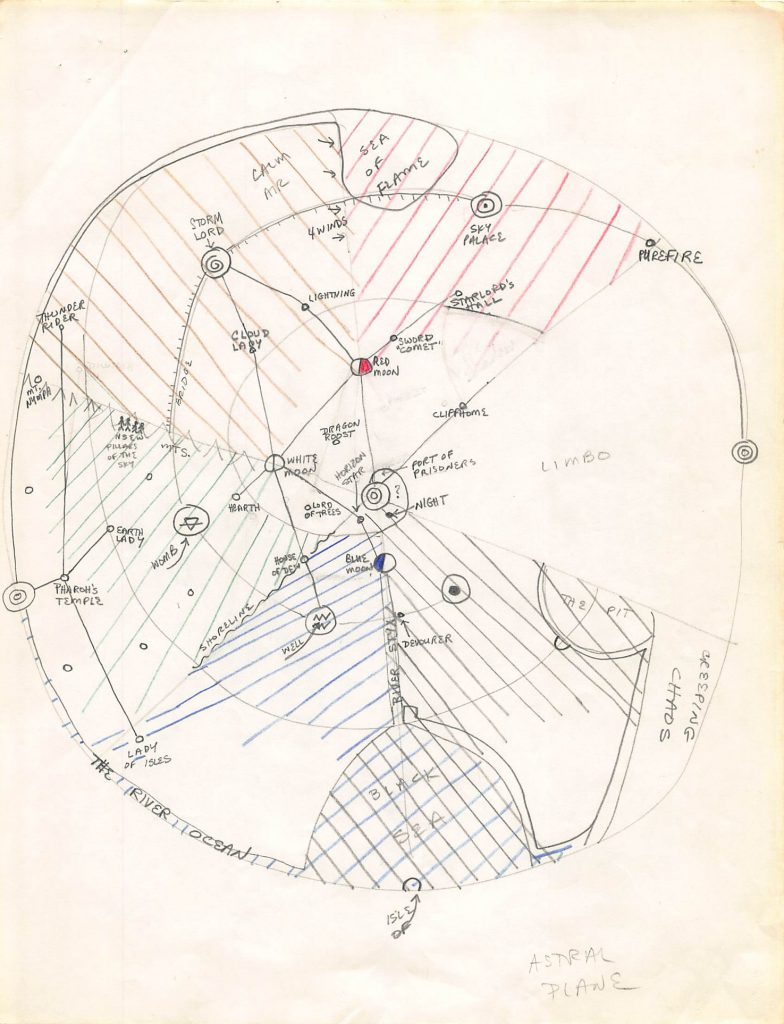
Jeff likes to use one of those maps from Greg (above) as the basis for exploring the Hero Plane. This is in fact one of the maps we used during our heroquest at ChaosiumCon.
So when thinking about any heroquest, I start by looking at one of Greg’s old Hero Plane maps. This is a map of archetypes – and not the same thing as the Mythic Maps (which show the relationship of known mythic events and how they shaped the world). I think of this like a guide to Dreams or even something like the Sefirot. Perhaps our quest will be to travel from the Home of the Storm Lord over the Bridge through the Calm Air (making your way past the Four Winds) across the Sea of Flames to make your way to the Sky Palace in order to secretly aid the Imprisoned Queen and bring her back to the Womb. We associate these places with mythic events and places (is the Womb the great temple of Ezel, the Paps, or just the Earth Temple basement?), but you create your own story when you go there.
Yep, we did some of that. But we ended up at the White Moon’s palace and broke some shit by mistake. We went through a bunch of other weird scenes and ended at the Pit, trying to save Orlanth… fun times.
Then arm the players with a few stories. Maybe they learn a secret from a God Learner scroll that it is possible to befriend Mr. Racoon who can sneak you into the Imprisoned Queen’s chambers. Or perhaps they learned something in the Cradle that lets you travel across the Black Sea to the River Styx or realize that they already saw this scene in Kakstan’s Art Gallery. However you do it, try to tie this into their experiences in the game.
If they have already been on a heroquest, even better – rope that experience into this.
My current heroquesting game has the Trickster equipped with such inside knowledge: the Golden Age has invaded the tribal lands, but he knows about a backdoor in the Sun Emperor’s ziggurat… they just got there last week, so we’ll see if that helps, or makes things worse…
Anyway, read the note for more advice from Jeff… while we wait for the official heroquesting rules of course.
Detecting and Tolerating Chaos
This thread on BRP Central features a couple of comments by Jeff on the presence of Chaos in our midst:
Unlike most other organized states in Genertela, the Lunar Empire tolerates the worship of Chaotic entities. The Crimson Bat, Primal Chaos, Nysalor, and of course the Red Goddess are state sponsored Chaos cults. But ideologically it is difficult for Lunar officials to prohibit worship of Vivamort, Krarsht, Mallia, Thed, etc.
Now many things these cults do – murder, rape, spread of disease, etc. is going to get repressed by Lunar officials. But even the Orlanthi have Black Fang and Lanbril. Even in the Lunar Empire these cults need to operate in the shadows away from Yelms light. But of course it is much easier for them to exist than in Theyalan lands where their very existence is taboo.
The same way that I use organized crime as an inspiration for some Chaos cults, you can also use real world governments as inspiration for how the Lunar Empire walks a fine line with regards to these cults. For instance, the US government deals with a lot of nasty organizations behind the scenes… take a look at the FBI and, obviously, the CIA’s history. That’s all you need to know to get a plausible Lunar Empire that condemns Broos and Vampires but also works with them when needed. On this, Jeff explains:
And of course more obvious manifestations of Chaos are going to get the ire of some power non-Red Goddess cults in the Lunar Heartlands. For example, Yelm is an enemy of Bagog, Cacodemon, Krarsht, Krjalk, Primal Chaos, Thanatar, Thed, etc. The Yelm cult is an enemy of the Crimson Bat, but the head of the Yelm cult, the Red Emperor, officially tolerates the Crimson Bat.
So although Thanatar’s existence is tolerated by the Red Emperor, the Thanatar cult needs to operate largely in the shadows. Broo are tolerated by the Red Emperor, but if they start acting broo-ish, they still get hunted down and killed (unless they can be made useful and sent against enemies of the Emperor). I imagine that religious riots and angry protests happen even in the Lunar Heartlands.
In game what that means is that Thanatar cults exist in the Lunar Heartlands, but they are likely covertly coopted by the Red Emperor and other Lunar officials. They are tolerated, so long as their actions do not threaten the social order or the Lunar religion. Of course, such cults chafe at such restrictions, so from time to time the Red Emperor uproots them.
Of course in “pure” Orlanthi (non-Lunar) lands, there’s no head of state that tolerates any Chaotic shenanigans. But even there it can get tricky:
Something a lot of people seem unclear about – there is no universally accepted way to know something is Chaotic. Some cults claim to have magic that identifies chaotic things but that magic curiously fails when confronted with some obviously Chaotic entities. The Storm Bull cult is sworn to destroy Chaos and claims to be able to “sniff” Chaos. But even their senses fail to register some obviously Chaotic things – so clearly there is secret Chaos everywhere.
Statistics dictate that most Storm Bull initiates will, what, detect Chaos correctly only half the time? Two thirds of the time? Plus all the fumbles where their senses completely betray them and they completely fuck things up? Sure, they’re loud and drunk and dangerous, but I think their word is taken as one indicator, not as the absolute truth.
People with third arms, glowing eyes, weird misshapen bodies, goat heads, etc., are obviously Chaotic. In Theyalan or Malkionni lands such people are often accused of being Chaotic monsters and killed, or just lynched by angry mobs (assuming they can muster the courage to act). In the Lunar Empire such people are accepted as people and judged by their actions. That being said, iff there are unsolved crimes, such people are often accused of being active worshipers of evil Chaotic deities and blamed for the crimes. But they at least enjoy the official tolerance and protection of the Lunar rulers.
I also like this suggestion by Jeff that things can be confusing or misleading:
[…] Chaos Gift and Chaos Features usually have overt manifestations. But is that tusked monster a human with a Chaos Feature or just a dark troll? Is that a broo with a harmless appearing Chaos Feature or just a satyr?
Within most human societies, Chaos cults are viewed as an abomination. Theyalans, Praxians, Malkioni, trolls, elves, etc., aren’t going to tolerate the worship of Chaotic entities in areas they control. When they learn of such activities, they are going to stop it with force if they can (the Storm Bull cult is kind of ideal for this).
Of course, this assumes the authorities: 1. know that Chaotic worship is going on, and 2. can stop it at a reasonable cost. Most Chaos cults operate in secret or far away from their enemies. Many Chaos temples are hidden and well defended. For example in Dragon Pass, Snakepipe Hollow and the Upland Marsh have the most Chaotic activity- these are places that are dangerous to go to and it is easy to hide your activities there. There are likely other Chaos cult activities, but they need to stay hidden and secret, lest they are killed by trolls or local authorities. This helps explains the survival of Krarsht, for who is better at hiding than the Hungry Mother?
The Lunars are different. Chaos cults are not viewed as abominations per se, but are judged on whether they serve the interests of the Red Goddess and her temporal viceroy, the Red Emperor. So maybe a Thanatar temple can operate under the supervision of the local satrap, IF it pays enough money, agrees to not commit crimes against Lunar cultists, and performs plenty of useful services to the local magistrate. Maybe the local magistrate will turn a blind eye to the activities of the local Krarsht ring for money and services. And as long as the satrap is fine with this (and remember they are pretty much all Red Goddess initiates), then no problem. But if the Chaos cults cause problems for the satraps (especially if they cause disturbances that make tax collection difficult), then hunt them down and kill.
Yelmalion Character Concepts
At first glance, Yelmalio seems so one-dimensional that it’s hard to imagine Yelmalion character concepts as anything else than soldiers and guards. But Jeff has some interesting comments on this:
Yelmalio is the Frontier God of Civilization. He brings Light to the quarrelling Storm tribes. He is a god of honour, a god of citizen-soldiers. He has a soldier aspect, a mystic aspect, and even a scholar aspect. His cult preserves their ways and identity despite being greatly outnumbered by those who do not follow his ways.
The “naive reading” of Yelmalio’s myth is that he kept some lights on during the Great Darkness, helping people against the creatures of Darkness and Chaos. But I guess that this “light” could be anything. He’s here to help the people who are in shitty situations and shitty places.
I suppose that’s why you can find Sun Domes, or at least Sun Dome ruins, in several remote places of Genertela. Remember that Sun Dome temple I mentioned in the East Wilds above? Maybe it’s helping the local with more than just stabbing Chaos creatures and trolls. Maybe it helps with food, water, literacy, traditions, hunting, agriculture, and so on too… not necessarily directly, but possibly by acting as a platform that boosts these things, sort of like a friendly community centre that hosts courses, activities, and conventions or something. I’m not sure yet where this goes, but it’s intriguing.
Community Roundup
The community roundup is our highlight of interesting things being mentioned in the Glorantha-related Facebook groups, sub-Reddits, and other similar online places.
RuneQuest Marketing by Kieron Gillen

Kieron Gillen, author of many fine comics including The Wicked + The Divine and, for the roleplayers in the audience, DIE, has recently taken a closer look at RuneQuest after many years of passing it by… he has some opinion about how Chaosium should market it:
Everyone goes on about Runequest being this classic RPG fantasy world of bronze age culture and myth and stuff, but they could have just skipped all that and just said YOU CAN PLAY A LADY WHO RIDES A BISON AND USES A LANCE ON BISON-BACK.
As a teenager, I always thought Runequest as the sort of RPG that grown-ups with 1970s beards would play and then perhaps have a fondue, but THERE WERE BISON RIDERS ALL ALONG.
The Runequest fans who are noting all the other awesome stuff in Runequest are making my point. LEAD WITH THE LLAMA WARRIORS. Call the game RUNEQUEST: YOU CAN RIDE A FUCKING BISON. Don’t let someone who’s played RPGs all his life reach the age of 47 and not know this.
Vasana riding a bison is also my favourite thing from my early discovery of RuneQuest and Glorantha so I totally agree here.
Coffeemancer’s Art Dump
I love Coffeemancer’s meme-friendly art so much that we actually interviewed him for the Glorantha Initiation series! He recently dumped a bunch of old and new art on Twitter and it’s wonderful… Here are some Lunars and Orlanthi in the style of the Asterix comicbooks:
Next are some Hippo riders, and a Garsting war-chariot (“I imagine the Garstings to be descendants of a Wheel clan and the goat herders that roamed around the Oslir river“):
Coffeemancer’s current game seems to be located in the Torkani tribe, so he drew their Torkani adventurers:
Dan Barker’s Troll Statue
Illustrator Dan Barker has made this Troll statue drawing and is wondering if he’s going to finish it… what do you think?
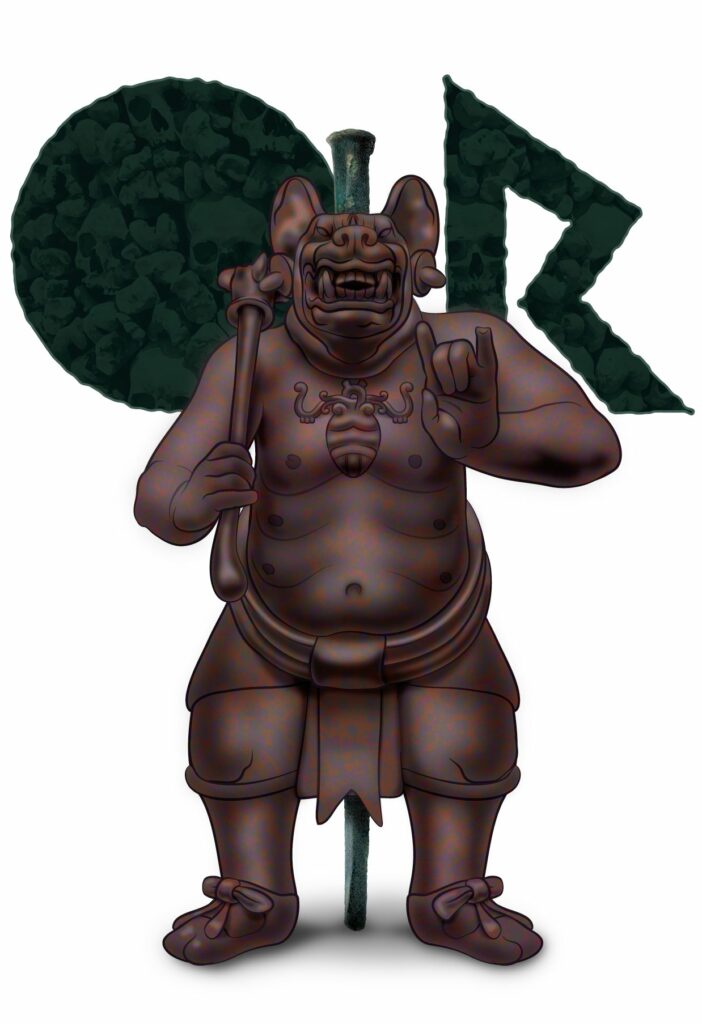
Bryon Reviews The Red Book of Magic
Bryon is done with the Weapons & Equipment Guide (mentioned last week), and now he’s doing the RuneQuest spellbook… letter by letter! Well, not like, each letter of the text (although I would frankly love to see someone do that), but the first video is all the “A” spells.
Thank you for reading
That’s it for this week! Please contact us with any feedback, question, or news item we’ve missed!


